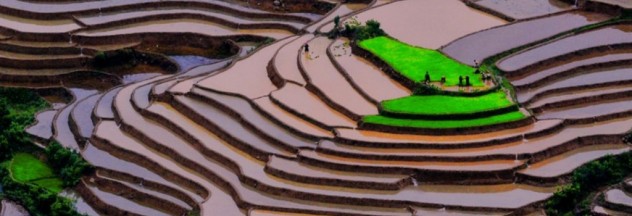Mu Cang Chai, a district of Yen Bai Province in the Northern upland portion of Vietnam, has amazing terrace rice fields and interesting ethnic minority groups, making it a fast-growing tourist destination in the world today.
Beginning mid-September to late October, the famous rice fields turn yellow. This is also the time when the weather is at its best, attracting visitors from all over the globe. The best terrace rice fields in the place are found at Tu Le Valley, Khau Pha Pass, La Pan Tan, Cau Ba Nha and Che Cu Nha Communes, all creating a breathtaking and unforgettable sight.
It takes about three days and two nights to complete visiting all the top terrace rice fields at Mu Cang Chai, and between 7 a.m. to 9 a.m. are the best times to photograph them. There are other significant sites to visit at Mu Cang Chai. La Pan Tan is an officially-recognized tourist attraction declared as such in 2007 which showcases the life of the H’mong people. A typical H’mong house is covered with ripe corns on the terrace and surrounded by wooden cages for pigs and cows. The men work at the fields while the women either stay home to take care of their children or go with their husbands. They take an afternoon break in their respective homes, cooking their own food on a small stove and gathering together as a family to eat. They play a traditional pan-pipe called “khen,” performed by the men to catch the attention of the women.
Cau Ba Nha is another popular spot known for its “mam xoi,” a big, round-shaped terrace rice field situated at the peak of a mountain. It is located about 10 kilometers from the capital of Mu Cang Chai and although the way is rough and muddy, tourists still flock to the place because of its renowned beauty. Visitors can either rent a motorbike taxi called “xe om” or take a 30-minute hike to the top.
Khau Pha Pass is one of the most impressive passes in the whole country where tourists can almost touch the clouds while enjoying the equally splendid view of the valleys of the H’mong and Thai ethnic minority groups below.
Lodging at Mu Cang Chai is quite convenient, since several hotels and hostels can be found especially in the vicinity of Tu Le Commune, Khau Pha Pass and Nghia Lo Town in Yen Bai Province. The Suoi Mo Hotel comes most recommended with its three-star rating and excellent service. It is located at Dien Bien Street, Yen Bai Province.
But between the middle of September and late October when the rice fields turn yellow and the weather is ideal, all hotel bookings are almost guaranteed to be full so guests should reserve their accommodations at least a month before.
Among the top local delicacies at Mu Cang Chai and Yen Bai Province in general are Muong Lo’s Tu Le sticky rice and green rice flakes from Tu Le Commune, Van Chan District. Both are known for their light sweet and sticky flavours and pleasant smell. Salmon, sturgeon pots, fried bumble bees, steamed chicken, and tao meo are other must-try foods in the place. The latter is a certain species of small apples in the mountainous regions and is considered a special fruit in the province as it is proven to cure stomach pains, high blood pressure and even heart-related diseases. Between September to October is also the period when the best tao meos are grown.
Mu Cang Chai can be reached by taking a plane from Ho Chi Minh City to Hanoi and then either renting a car, taking a bus or riding a motorbike and travel around 280 kilometers to arrive at the capital.


I was in Mu Cang Chai two years ago it was an amazing experience. The views are unbelievable, like something you see on movies. It’s truly a wonder and anyone in Vietnam should try and visit.